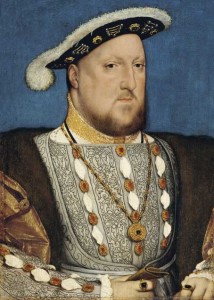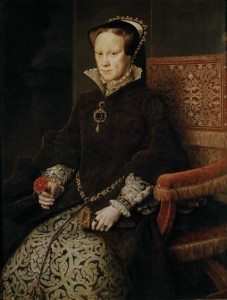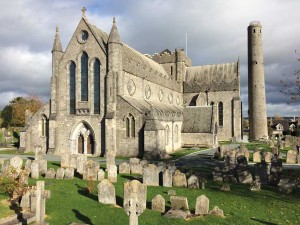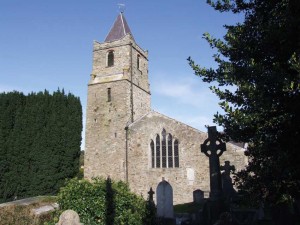The Reformation in Ireland: interpretations old and new
Published in Early Modern History (1500–1700), Features, Issue 2 (March/April 2016), Volume 24WHY DID THE PROTESTANT REFORMATION FAIL IN IRELAND?
By Henry A. Jefferies

Henry VIII c. 1537 by Hans Holbein the Younger. Brendan Bradshaw has shown that Henry VIII’s Reformation was accepted ‘with alacrity’ by the Anglophone élites in Ireland. But was it a truly ‘Protestant’ Reformation?
In terms of sheer importance in Irish history, few events compare with the Reformation. In particular, the contrasting outcomes of the Reformation in Ireland and Britain had profound consequences for Anglo-Irish relations over subsequent centuries, and still affect life in Northern Ireland to this day. Yet circumstances have conspired to hamper our understanding of the Reformation in Ireland. The loss and destruction of Irish archives and physical evidence are very difficult to overcome. The dramatic collapse of Christianity in Ireland over recent decades has sapped interest in the subject. Furthermore, the dominance of constitutionalist historians in Irish third-level history departments has caused the Reformation in Ireland to be studied primarily as a constitutional rather than as a religious phenomenon. Let us consider five prevailing assumptions about the Reformation in Ireland in the light of recent research.
1. ‘Not far short of total breakdown’?
A generation ago there was a consensus that the late medieval Irish church was on the verge of ‘total breakdown’. Historians were never quite sure how to relate that assumption to Ireland’s subsequent experience of the Reformation and tended to sidestep the issue. Recent studies, however, based primarily on ecclesiastical records and surveys of the architectural remains of late medieval church buildings, have overthrown the notion that the church in Ireland was on the verge of ‘total breakdown’ on the eve of the Reformation. Evidence from across the island shows that it was actually experiencing a remarkable renewal right up to the moment of Henry VIII’s breach with Rome. The Irish church operated through a dense network of parishes and chapelries, with radii of only a mile or so in the Pale and two miles over much of Gaelic Ireland, which were staffed by plenty of priests and supervised by many able bishops.
Given the fragmentation of political authority in Ireland in the sixteenth century, and the consequent disorders that wracked many areas, the Irish church authorities were not always able to call on the secular authorities to enforce canon law as rigorously as their counterparts in more settled regions of Europe. In a context of wide-scale economic underdevelopment, impoverished congregations could not always afford to maintain church buildings in perfect condition, or to subsidise the education of many parish clergy to university standards. Yet there is evidence of many new churches being built or renovated in the century before the Reformation. Lay people’s wills, their foundation of chantries, their election of churchwardens and the growth of religious confraternities, not to mention the remarkable burgeoning of the mendicant orders, especially the Franciscans, reflect widespread commitment to Catholic doctrines and practices and a keen attachment to the institutional church on the eve of the Reformation. That was bound to influence Irish responses to the Reformation.
2. ‘Accepted with alacrity’?
Brendan Bradshaw, in The constitutional revolution in Ireland in the sixteenth century, declared that Henry VIII’s Reformation was accepted ‘with alacrity’ by the Anglophone élites in Ireland. That bold assertion contradicted a long-standing Catholic interpretation to the contrary, but was solidly based on the facts that the Irish parliament of 1536/7 endorsed the king’s ecclesiastical bills with relatively little demur and that several of the local élites collaborated with the crown in suppressing religious houses across much of Ireland. Subsequent research has consolidated and extended Bradshaw’s insight. We now know that Henry VIII succeeded in displacing papal jurisdiction over much of the Irish church to quite a remarkable degree. Small wonder that the first Jesuit missionaries to the country wrote a pessimistic report in 1542 about the future prospects of the Catholic Church in Ireland.
It is important to bear in mind, however, that Henry VIII’s was not a Protestant Reformation. Martin Luther caustically quipped: ‘Squire Henry meant to be God and do as he pleased’. In fact, the king had written a book defending Catholic doctrines against Luther, for which a grateful Pope Leo X granted him the title of ‘Defender of the Faith’ in 1521, the Latin initials of which are still inscribed on British coins to this day! Henry was concerned primarily with jurisdiction over the church in his domains, and its revenues, not with Reformation theology. The Catholic Mass and other Latin rituals were retained in Henry’s church. His Reformation, after some initial uncertainty as to where it would culminate, was widely acquiesced in in Ireland because it did not dispute fundamental Catholic teachings. We should not confuse acceptance of Henry VIII’s idiosyncratic royal supremacy with enthusiasm for Protestantism.
3. A Marian ‘watershed’?
Bradshaw suggested that the reign of Mary (1553–8) marked a ‘watershed’ in Ireland’s experience of the Reformation, between the conformity that characterised the years preceding it and the resistance to religious change documented subsequently in Elizabeth’s reign. That view was fiercely rejected by Nicholas Canny, who highlighted evidence that the Counter-Reformation had not become established in Ireland in Mary’s reign.
Yet Mary’s reign was not without significance for Ireland’s Reformation story. Recently it has been shown that the queen moved quickly to support the restoration of Catholicism, and Cardinal Reginald Pole, after a tardy start, involved himself directly in consolidating that restoration. Pole worked with the queen in devising a radical programme to invest the impropriated tithes held by the crown since the dissolution of the monasteries into funding the training of priests in the future and enhancing the financing of their ministries. Pole’s programme may have been one of promise rather than achievement in Ireland, but it was significant nonetheless.
Mary and Pole promoted a team of Catholic stalwarts to spearhead the restoration of Catholicism in Ireland. The most important of the promoted men were Irish religious exiles who were put into key dio-ceses: George Dowdall, archbishop of Armagh; William Walsh, bishop of Meath; and Thomas Leverous, bishop of Kildare. John Thonery, the Marian bishop of Ossory, showed himself committed to the Catholic restoration from the moment of his consecration, and he distinguished himself as a Catholic dissident under Elizabeth. Hugh Lacey, the Marian bishop of Limerick, would distinguish himself in Elizabeth’s reign by actively supporting a papal mission intended to thwart the queen’s Reformation.

Queen Mary by Antonis Mor, 1554. Did her reign mark a ‘watershed’ in Ireland’s experience of the Reformation?
The weakest link among Mary’s appointments to Irish dioceses was the one Englishman she promoted, Hugh Curwen, archbishop of Dublin. Curwen had had to be reconciled to the Catholic Church by Cardinal Pole because of heresy and schism but, tellingly, he avoided swearing an oath to the pope. Subsequently he told Elizabeth that he had no qualms about swearing an oath acknowl-edging her as the supreme governor of the church. Mary’s decision to promote Curwen, probably because of his likely usefulness in her civil administration in Dublin, proved to be a costly mistake for her religious programme.
Nonetheless, Mary and Pole may have done enough to ensure that the response to Elizabeth’s Reformation in Ireland was much more robust than that accorded to Edward VI’s Reformation. Though there was very strong feeling against the religious changes decreed under the boy king—there was, for example, a call in Meath for the burning of Bishop Staples as a ‘heretic’ after he delivered his first Protestant sermon in 1548—the Irish reaction to Edward’s increasingly radical Protestant Reformation was remarkably inchoate. The success of John Bale, the Protestant bishop of Ossory, in winning support for the Reformation in Kilkenny in 1553 suggests that Catholicism might have been vulnerable to an earnest campaign in favour of Reformed Christianity had the young king lived for as long as might reasonably have been expected. Archbishop Dowdall’s flight into exile in 1551 not only was symptomatic of a wider failure in Catholic leadership but also suggests a crisis of confidence about the future prospects of Catholicism in Ireland. Yet Mary’s reign may have helped to restore something of that confidence ahead of the Elizabethan religious maelstrom.
4. A ‘quiescent phase’?
Since 1979 generations of Irish history undergraduates have been taught that there was a ‘quiescent phase’ until the late 1580s or ’90s, during which time people in Ireland conformed quietly to Elizabeth’s Reformation. Constitutionalist historians asserted that the subsequent rejection of the Reformation was prompted by constitutional grievances rather than religious preferences. More recently, however, overwhelming evidence has contradicted the notion of a ‘quiescent phase’ in the first half of Elizabeth’s reign, and controverts the attempts made to synchronise the failure of the Reformation with the political alienation evident in the last decades of her reign.
Part of the reason for that fundamental misunderstanding of the Elizabethan Reformation in Ireland was the failure to see it in its broader, English context. In England the Catholic Church was quickly decapitated and the crown promoted Protestants to senior positions in the church and universities with striking speed after the English Reformation parliament of 1559. In contrast to England, after the Irish Reformation parliament of 1560, the crown could not find Protestants for promotion in Elizabeth’s other kingdom. It could not insist that the clergy or secular officials in the boroughs and shires take the oath of supremacy—even in Dublin and the Pale—which meant that the Reformation was virtually unenforceable in Ireland. People would not attend Protestant services voluntarily, and when on occasion they were forced to attend they disrupted the services and behaved as though they were at a ‘May game’.
The queen was obliged to establish the Irish Ecclesiastical Commission in 1564 to compel people to attend Protestant church services and not disrupt them. Even then the lords and gentry of the Pale continued to boycott prayer-book services, while the queen’s officials dared not provoke the ‘multitude’ who would not conform. The population was invariably characterised by crown officials as ‘stubborn’ and ‘obstinate’ in religion. The term ‘church papist’ was never used to describe anyone in sixteenth-century Ireland, but has been misapplied to Ireland by some historians. Compared with England, the resistance encountered by the Elizabethan Reformation in Ireland was quite extraordinary from the start. One need only read any contemporary report to see that there was no ‘quiescent phase’.
5. ‘Mal posée’?
The question of why the Reformation failed in Ireland is not, as has been claimed, mal posée but it was prématurée before sufficient research had been conducted to sustain convin-cing answers. Contemporaries were unanimous that it had failed comprehensively before Elizabeth died. Catholic and Protestant comment-ators estimated the number of Irish-born Protestants in the entire country at between 40 and 120. In Dublin only twenty Irish-born householders attended Protestant church services at the end of the sixteenth century, and only four of them would receive communion. Only five individuals attended Protestant church services in Cork in 1595. There were five children in the Protestant school in the populous diocese of Meath in 1604. By any standard the scale of failure was overwhelming.
To account for the failure of the Reformation in Ireland a number of variables have to be considered. The strength of popular attachment to Catholicism on the eve of the Reformation, which is becoming ever clearer as research progresses, was clearly significant in shaping Irish responses to Reformation theology. Close study of the evidence from well-placed contemporaries throughout Elizabeth’s reign, Catholic and Protestant, English and Irish, shows the persistence of Catholic convictions among the élites in Ireland and among the ‘lesser orders’. Colm Lennon’s study of Dublin is exemplary in that regard. The general refusal to subscribe to the Elizabethan oath of supremacy in Ireland, the refusal to attend Protestant church services and the disruptive behaviour of those forced to attend against their will, the withdrawal of voluntary financial support from local churches as they were Protestantised and the widespread disappearance of the office of churchwarden were forms of resistance to the new religious order that the crown, without the cooperation of the local clergy and law officials, simply could not overcome.
Perhaps Elizabeth’s Reformation might have made some real progress in Ireland if Protestant preachers could have been found to persuade people to embrace its doctrines. There was, however, no indigenous community of Protestants in Ireland from whom a Reformation ministry could be recruited. There were no Irish Protestant scholars to staff any hypothetical Irish university to educate aspirant Reformation ministers, had any such aspirants existed. The virtual absence of Protestant preachers, of any nationality, meant that the Irish attachment to Catholicism, which was commented on by contemporaries, went unchallenged in many areas. The Elizabethan Reformation could neither be enforced nor propagated in Ireland in the absence of support from the local community.
Yet there remained the likelihood that Catholicism would atrophy over time, as Elizabethan bishops were appointed and they in turn promoted clergymen ordained with the Book of Common Prayer in place of Catholic priests, and took possession of church buildings, ecclesiastical real estates and tithes. The survival of the Catholic Church depended on its ability to sustain a Catholic ministry throughout Elizabeth’s reign. A continuing Catholic pastoral system was overseen by David Wolfe SJ, the papal commissary for Ireland from 1560. William Walsh, the deposed Marian bishop of Meath, played a crucial role in maintaining Catholicism in the Pale. From the early 1560s an underground network was in place to transport Irish priests and aspirant priests to Catholic colleges on mainland Europe. Meanwhile, the ministries of priests who remained in the established church were sup- plemented by independent chaplains and by tutors who ensured that the children of the élites received an unambiguously Catholic education, and by the preaching of friars, even in the Pale. From 1577 college-educated Catholic priests were returning to Ireland as harb-ingers of the Counter-Reformation. Once they created a parish system parallel to that of the established church the future of Catholicism in Ireland was assured.

St Canice’s Cathedral, Kilkenny. The fiery Protestant preacher John Bale, bishop of Ossory, has left us a very graphic impression of his ministry in Kilkenny in 1551. Although he encountered tremendous hostility from the local Catholic priests and many older citizens, he built up a remarkable following among the young men of the town. His experiences show that the failure of the Reformation in Ireland was not inevitable. (Arran Q. Henderson)
Conclusions
The failure of the Reformation in Ireland was not inevitable. Archbishop Dowdall’s flight into exile in 1551 shows that no one could have been confident as to the ultimate outcome of the Reformation in Ireland. The absence of an indigenous Protestant community at the start of her reign meant, however, that Elizabeth’s administration in Ireland struggled in vain to enforce and propagate her Reformation from 1560. One might speculate, counterfactually, what might have happened had circumstances been different or had different strategies been employed to advance the Reformation in Ireland. Nonetheless, it is now obvious that the Reformation had failed decisively in Ireland before the Virgin Queen died.
Henry A. Jefferies is the Head of History at Thornhill College, Derry.

St Multose Church, Kinsale, Co. Cork, founded in 1190—one of the very few medieval churches in Ireland to remain in continuous use despite the Reformation. Most fell into ruins as parishioners abandoned them after they were converted for use for Protestant services. (Canon David Williams)
Further reading
H.A. Jefferies, The Irish church and the Tudor Reformations (Dublin, 2010).
H.A. Jefferies, ‘Elizabeth’s Reformation in the Irish Pale’, Journal of Ecclesiastical History 66 (2015).
H.A. Jefferies, ‘Why the Reformation failed in Ireland’, Irish Historical Studies 40 (2016).
C. Lennon, The lords of Dublin in the age of Reformation (Dublin, 1989).
















